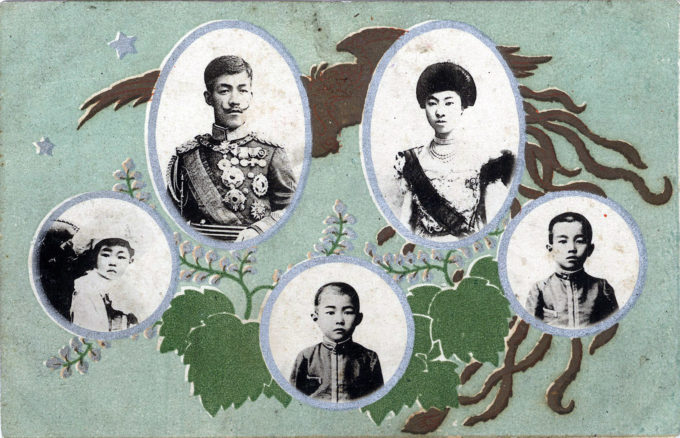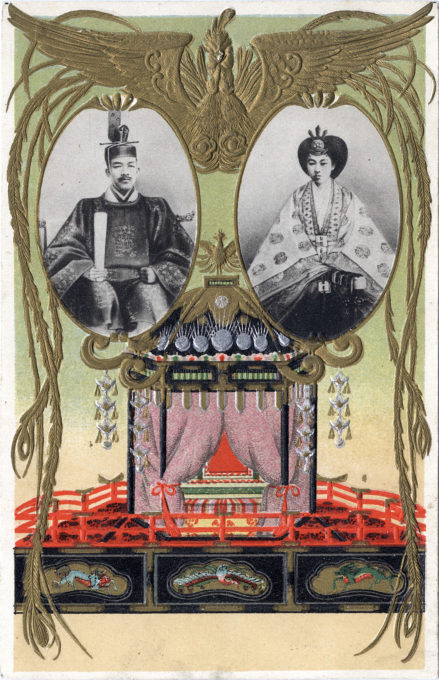
Crown Prince Yoshihito (future Emperor Taisho), Princess Sadako (future Empress Teimei) and children, c. 1910. Left-to-right: Prince Nobuhito (Takamatsu), born 1905; Prince Yasuhito (Chichibu), born 1902; and the eldest, Prince Hirohito (future Emperor Showa), born in 1901. One more child, a fourth son, Prince Takahito (Mikasa), would be born in 1915. The future empress openly objected to Japan’s growing militarism and involvement in World War II. From 1943, she worked behind the scenes with Prince Takamatsu to bring about the resignation and downfall of Prime Minister Hideki Tōjō.
See also:
Enthronement of Emperor Taisho commemorative postcard, 1915.
Taisho Mausoleum, Hachioji, c. 1930.
“The emperor Taisho had been a sickly child, who early exhibited signs of serious mental instability as well as sadistic tendencies. Those charged with his upbringing did their best to conceal the physical and mental frailty of the crown prince and heir apparent – who in fact looked rather dashing as a young man – from all outside the innermost circle.
“A marriage was arranged when he was 20 years old. His 16-year-old bride was Sadako, who was the daughter of Prince Kujo Michitaka. Sadako was both intelligent and in excellent health. She had a tranquillising influence on here husband, bearing him four sons in all, the first a year after the wedding ceremony and the last in 1915, shortly before his breakdown.
Emperor Taisho and Empress Teimei, 1925. Commemorative postcard for their Silver Wedding Anniversary (1900). Then-Crown Prince Yoshihito married 15-year-old Kujō Sadako in 1900. She had been carefully selected by Emperor Meiji for her intelligence, articulation, and pleasant disposition and dignity – to complement Prince Yoshihito in areas where he was lacking.
“… For several years Taisho as crown prince was able to undertake carefully supervised engagement, and in particular those which provided opportunities for him to indulge his taste for dressing up in military uniform. He was the first Japanese crown prince to travel outside the country, being taken on an official visit [in 1907] to the Empire of Korea, at that time a Japanese protectorate.
“He was capable of stumbling through short formal speech, and his hesitancy was not often noticed; Japanese dignitaries were and remain to this day poor orators.
“… The emperor Taisho was seen by all members of the government and many other politicians to be incapacitated when, at the formal opening of a session of the national Diet, he rolled the text of his speech into a tube and surveyed its members through it as though it were a telescope … In its aftermath the authorities faced a problem of their own making.
“In former times the obvious course would have been abdication, but this had been ruled out as recently as 1889 by the Imperial Household Law. Gods do not abdicate.
“The only course now open to the government was to arrange for Taisho to retire completely from this imperial duties, but technically to remain on the throne for the rest of his natural life, with his son the crown prince acting as his regent. Fortunately Prince Hirohito, who had recently returned from a successful European tour, was a robust young man of 20 in full possession of all his facilities, and late in 1921 the regency was proclaimed.
“Taisho spent his last five years in seclusion, cared for by his principal consort Sadako, now the empress Teimei … [She] survived until well after the Second World War, greatly loved by her grandson the present emperor [Akihito].”
– The Chrysanthemum Throne: A History of the Emperors of Japan, by Peter Martin, 1997


